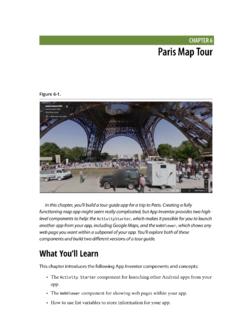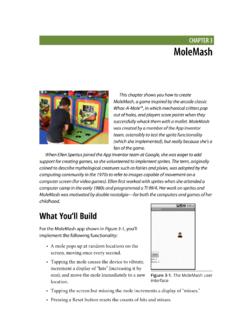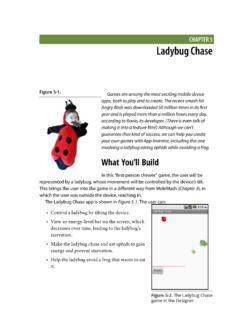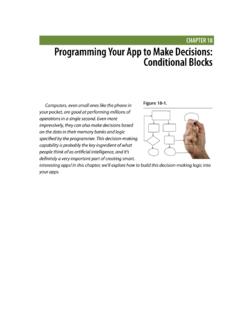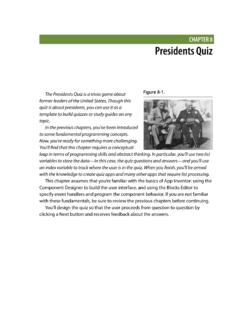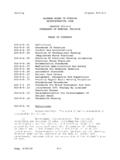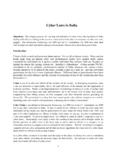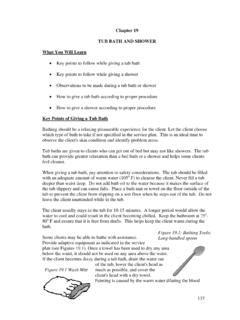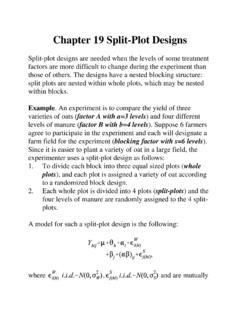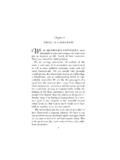Transcription of CHAPTER 19 Programming Lists of Data - …
1 Figure 19 Programming Lists of DataAs you ve already seen, apps handle events andmake decisions; such processing is fundamental tocomputing. But, the other fundamental part of anapp is its data the information it processes. Anapp s data is rarely restricted to single memory slotssuch as the score of a game. More often, it consistsof Lists of information and complex, interrelateditems that must be organized just as carefully asthe app s this CHAPTER , we ll examine the way App Inventor handles data. You ll learn thefundamentals of Programming both static information, in which the data doesn t change,and dynamic information, in which data is entered by the end user.
2 You ll learn how towork with Lists , and then you ll explore a more complex data structure involving Lists oflists and a multiple-choice quiz apps process Lists of data. For example, Facebook processes your list offriends and Lists of status reports. A quiz app works with a list of questions andanswers. A game might have a list of characters or all-time high specify list data in App Inventor with a variable, but instead of naming a singlememory cell with the variable, you name a set of related memory cells. You specifythat a variable is multi-item by using either the make a list or create empty listblocks.
3 For instance, the variable phoneNumbers in Figure 19-1 defines a list of 19-2. phoneNumbers names three memory cells initialized with the numbersshownCreating a List VariableYou create a list variable in the Blocks Editor by using an initialize global variableblock and then plugging in a make a list block. You can find the make a list blockin the Lists drawer, and it has only two sockets. But you can specify the number ofsockets you want in the list by clicking on the blue icon and adding items, as depictedin Figure 19-3. Click the blue icon on make a list to change the number of itemsYou can plug any type of data into the item sockets of make a list.
4 For thephoneNumbers example, the items should be text objects, not numbers, becausephone numbers have dashes and other formatting symbols that you can t put in anumber object, and you won t be performing any calculations on the numbers (inwhich case, you would want number objects, instead).Selecting an Item in a ListAs your app runs, you ll need to select items from the list; for example, a particularquestion as the user traverses a quiz or a particular phone number chosen from a access items within a list by using an index; that is, by specifying a position in thelist. If a list has three items, you can access the items by using indices 1, 2, and 3.
5 Youcan use the select list item block to grab a particular item, as shown in Figure 19-4. Selecting the second item of a list296 CHAPTER 19: Programming Lists of DataChapter 19, Programming Lists of DataWith select list item, you plug in the list you want in the first socket, and theindex you want in the second socket. For this phoneNumber sample, the result ofselecting the second item is 333 4444. Using an Index to Traverse a ListIn many apps, you ll define a list of data and then allow the user to step through (ortraverse) it. The Presidents Quiz in CHAPTER 8 provides a good example of this: in thatapp, when the user clicks a Next button, the next item is selected from a list ofquestions and previous section showed how to select the second item of a list, but how doyou select the next item?
6 When you traverse a list, the item number you re selectingchanges each time; it s your current position in the list. Therefore, you need to define avariable to represent that current position. index is the common name for such avariable, and it is usually initialized to 1 (the first position in the list), as demonstratedin Figure 19-5. Initializing the variable index to 1 When the user does something to move to the next item, you increment the indexvariable by adding a value of 1 to it, and then select from the list by using thatincremented value. Figure 19-5 shows the blocks for doing 19-6.
7 Incrementing the index value and using the incremented value to selectthe next list itemExample: Traversing a List of Paint ColorsLet s consider an example app with which the user can peruse each potential paintcolor for his house by tapping a ColorButton. Each time the user taps, the button scolor changes. When the user makes it through all of the possible colors, the app goesback to the first this example, we ll use some basic colors. However, you could customize thecode blocks to iterate through any set of an Index to Traverse a ListUsing an Index to Traverse a ListYour first step is to define a list variable for the colors list and initialize it with somepaint colors as items, as depicted in Figure 19-7.
8 Initializing the list colors with a list of paint colorsNext, define an index variable that tracks the current position in the list. It shouldstart at 1. You could give the variable a descriptive name such as currentColorIndex,but if you aren t dealing with multiple indexes in your app, you can just name it index , as in Figure user traverses to the next color in the list by clicking the ColorButton. Uponeach tap, the index should be incremented and the BackgroundColor of the buttonshould change to the currently selected item, as shown in Figure 19-8. Each tap of the button changes its colorLet s assume the button s background is initially set to Red in the ComponentDesigner.
9 The first time the user taps the button, index changes from its initial valueof 1 to 2, and the button s background color changes to the second item in the list,green. The second time the user taps it, the index changes from 2 to 3, and thebackground color switches to what do you think will happen the next time the user taps it?If you said there would be an error, you re right! index will become 4 and the appwill try to select the fourth item in the list, but the list only has three items. The appwill force close, or quit, and the user will see an error message like the one inFigure 19: Programming Lists of DataChapter 19, Programming Lists of DataFigure 19-9.
10 The error message displayed when the app tries to select a fourth itemfrom a three-item listObviously, that message is not something you want your app s users to see. Toavoid that problem, add an if block to check whether the last color in the list hasbeen reached. If it has, the index can be changed back to 1 so that the first color isagain displayed, as illustrated in Figure 19-10. Using an if to check whether the index value is larger than the length ofthe listWhen the user taps the button, the index is incremented and then checked to seeif its value is too large. The index is compared to length of list, not 3; this way yourapp will work even if you add items to the list.
